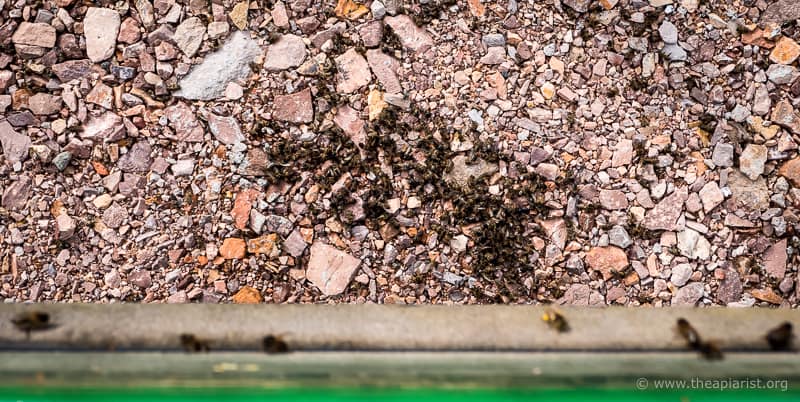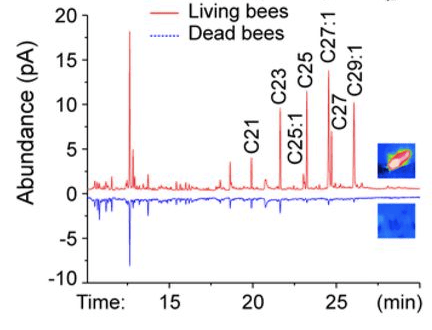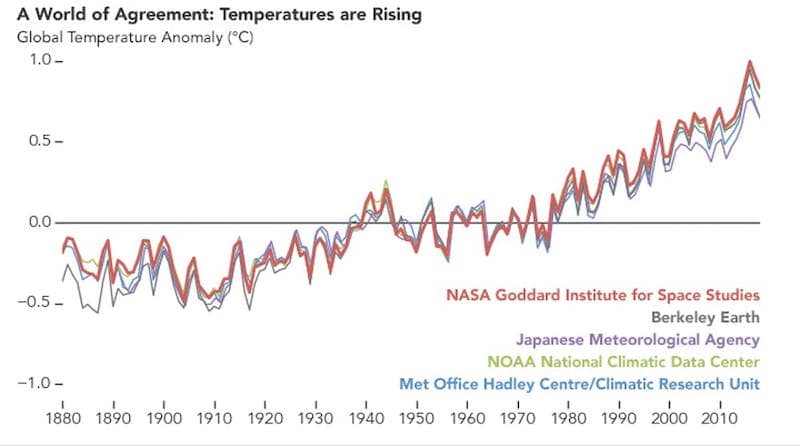The scent of death
It’s late May. Outside it’s dark, so you’re trapped inside until sunrise. Inside it’s warm, dark and humid. You and your sisters are crowded together with barely enough space to turn around.
And your mother keeps laying more eggs … perhaps 2000 a day. If it wasn’t for the fact that about 2000 of your sisters perish each day you’d have no space at all.
Most of them die out in the fields. Missing in action.
I counted them all out and I didn’t count them all back, as the late Brian Hanrahan did not say in 1982 😉
But some die inside. And in the winter, or during prolonged periods of poor weather, your sisters all die inside.
Which means there’s some housekeeping to do.
Bring out your dead
Dead bees accumulating in the hive are a potential source of disease, particularly if they decompose. Unless these are removed from the colony there’s a chance the overall health of the colony will be threatened.
Not all bees die of old age. Many succumb to disease. The older bees in the colony may have a higher pathogen load, reinforcing the importance of removing their corpses before disease can spread and before the corpses decompose.
Honey bees, like many other social insects, exhibit temporal polyethism i.e. they perform different tasks at different ages.
One of the tasks they perform is removing the corpses from the colony.
The bees that perform this task are appropriately termed the undertaker bees.
Gene Robinson in Cornell conducted observational studies on marked cohorts of bees. In these he identified the roles and activities of the undertaker bees. At any one time only 1-2% of the bees in the colony are undertakers {{1}}.
These are ‘middle aged’ bees i.e. 2-3 weeks after eclosion, similar to guard bees. Although called undertakers, they do not exclusively remove corpses. Rather they are generalists that are more likely to remove the corpses, usually depositing them 50-100m from the hive and then returning.
They preferentially occupy the lower regions of the hive – presumably because gravity means the corpses accumulate there – where they also perform general hive cleansing roles e.g. removing debris.
Bees, like all of us, are getting older all the time. Some bees may spend only one day as undertakers before moving on to foraging duties. Presumably – I don’t think we know this yet – the time a bee remains as an undertaker is influenced by the colony’s need for this activity, the laying rate of the queen and, possibly, the numbers of other bees performing this role {{2}}.
No no he’s not dead, he’s, he’s restin’!
In Monty Python’s Dead Parrot sketch Mr. Praline (John Cleese) argues with the shop owner (Michael Palin) that the Norwegian Blue parrot he’d purchased was, in fact, dead.
The shop owner tries to persuade Mr. Praline that the parrot is resting.
Or stunned.
Or pining for the fjords.
The inference here is that it’s actually rather difficult to determine whether something is dead or not {{3}}.
So if you struggle with an unresponsive parrot how do you determine if a bee is dead?
More specifically, how do undertaker bees in a dark, warm, humid hive determine that the body they’ve just tripped over is a corpse?
As opposed to a resting bee {{4}}.
The scent of death
Almost forty years ago Kirk Visscher at Cornell studied necrophoresis (removal of the dead) in honey bees {{5}}.
He noted that it had two distinct characteristics; it happened rapidly (up to 70 times faster than debris removal) and dead bees that were solvent-washed or coated in paraffin-wax were removed very much more slowly.
Kirk Visscher concluded that the undertaker bees “probably use chemical cues appearing very rapidly after the death of a bee” to identify the corpses.
Visscher studied honey bees, Apis mellifera. I’m not aware of any recent studies in A. mellifera that have better defined these ‘chemical cues’. However, a very recent preprint has been posted on bioRχiv describing how the closely related Eastern honey bee, Apis cerana, undertakers identify the dead.
As an aside, bioRχiv (pronounced bioarkive) is a preprint server for biology. Manuscripts published there have not been peer reviewed and will potentially be revised and/or withdrawn. They might even be wrong. Many scientists increasingly use bioRχiv to post completed manuscripts that have been submitted for publication elsewhere. The peer review and publication process is increasingly tortuous and long-winded. By posting preprints on bioRχiv other scientists can read and benefit from the study well before full publication elsewhere.
It’s also used as a ‘marker’ … we did this first 😉
The preprint on bioRχiv is Death recognition by undertaker bees by Wen Ping, submitted on the 5th of March 2020.
Odours and pongs
Death recognition in honey bees is rapid. Visscher demonstrated that a dead worker bee was usually removed within 30 minutes, well before it would have started producing the pong associated with the processes of decay.
Corpse recognition occurs in the dark and in the presence of lots of other bees. Logically, an odour of some sort might be used for identification. Both visual and tactile signals would be unlikely candidates.
In searching for the odour or chemical clues (the term used by Visscher), Ping made some assumptions based on prior studies in social insects. In Argentine ants a reduction in dolichodial and iridomyrmecin is associated with corpse recognition, and addition of these compounds (respectively a dialdehyde and a monoterpene) prevented necrophoresis.
Conversely, some social insects produce signals associated with death or disease. Dead termites give off a mix of 3-octanone, 3-octanol and the combination of β-ocimene and oleic acid production is a marker of diseased brood in honey bees.
What else could be assumed about the chemicals involved? Corpse removal is an individual effort. There’s only one pallbearer. Therefore the chemical, whatever it is, doesn’t need to be a recruitment signal (unlike the alarm pheromone for example).
Finally, the signal needs to operate over a very short range. There’s no point in flooding the hive with a persistent long-range chemical as that would make the detection of the corpse impossible.
Cuticular hydrocarbons
Cuticular hydrocarbons (CHC) are widely used in insect communication. They are long chain hydrocarbons (chemicals composed solely of carbon and hydrogen) that have many of the characteristics expected of a ‘death chemical’.
They are generally short-range, low volatility compounds. Honey bees use CHC’s for communication during the waggle dance and to distinguish colony mates by guard bees. They also have structural roles, being a major component of wax comb and, in the cuticle, they help maintain water balance in bees.
As would be expected from chemicals with a wide variety of roles, there’s a huge range of CHC’s. Taking all the above together, Wen Ping searched for CHC’s that functioned during necrophoresis.
Cool corpses and cuticular hydrocarbons
Wen studied undertakers removing segments of dead bees and determined that the chemical signal was most probably a component of the cuticle.
Living bees in his studies had a body temperature of ~44°C. In contrast, dead bees rapidly cooled to ambient temperatures. Wen demonstrated that corpse removal was significantly delayed if the corpses were warmed to ~44°C, but then occurred rapidly once they were allowed to cool. Finally, dead bees washed with hexane (which removes CHC’s) were removed even if the corpse was warm.
Taken together, these results suggest that a cuticular hydrocarbon that was produced and released from warm bees, but reduced or absent in cold bees, was a likely candidate for the necrophoresis signal.
But which one?
Gas chromatography
A gas chromatograph analyses volatile gases. Essentially gas vapour is passed through a thin coated tube and gaseous compounds of different molecular weights bind and elute at different times. It’s a very precise technique and allows all the components of a mixture to be identified by comparison with known standards.
Ping studied the volatile CHC’s in the airspace immediately surrounding dead bees or live bees using gas chromatography. There were some significant differences, shown by the absence of peaks in the blue trace of gases from the cold, dead bees. All of the peaks were identified and nine of the twelve peaks were CHC’s.
CHC’s with chain lengths of 27 or 29 carbons exhibited the greatest difference between live warm bees and cool dead bees and synthetic versions of these and the other CHC’s were tested to see which – upon addition – delayed the removal of dead bees.
Three had a significant impact in the dead bee removal assay – with chain lengths of 21, 27 and 29 carbons. These include the compounds heptacosane (C27H56)and nonacosane (C29H60).
Summary
The results section rather fizzles out in the manuscript posted to bioRχiv and I wouldn’t be surprised to see modifications to this part of the paper in a peer reviewed submission.
The overall story can be summarised like this. Live bees are warm and produce a range of CHC’s. Dead bees cool rapidly and some of the volatile CHC levels decrease in the immediate vicinity of the corpse. The undertaker bees specifically monitor the levels of (at least) heptacosane and nonacosane {{6}} as a means of discriminating between live and dead bees. Within 30 minutes of death local heptacosane and nonacosane levels have dropped below a level associated with life and the undertaker bee removes the corpse.
One final point worth making again. This study was conducted on Apis cerana. Our honey bees, A. mellifera, may use the same necrophoresis signals. Alternatively, they might use different chemicals in the same way.
Or they might do something else entirely.
Personally, I bet it’s a similar mechanism, potentially using different chemical.
There are mixed species colonies of A. mellifera and A. cerana. Do the undertakers only remove same-species corpses?
Global warming and hive cooling
The discussion of the bioRχiv paper raises two interesting points, both of which are perhaps a little contrived but still worth mentioning.
We’re living in a warming world.
Dead bees cooling to ambient temperature lead to reduced CHC production. If global temperatures rise, so will the ambient temperature. Potentially this could decrease the reduction in the levels of CHC’s i.e. the dead bees might not look (er, smell!) quite so dead. This could potentially reduce corpse removal, with the concomitant potential for pathogen exposure.
I suspect that we’ll have much bigger problems to worry about than undertaker bees if the global temperatures rise that high …
But Wen also points out that the rise in global temperatures is also associated with more extreme weather, including very cold weather. Perhaps cold anaesthetised or weak bees will be prematurely removed from the hive under these conditions because their CHC levels have dropped below a critical threshold?
Finally, do dead bees lying on open mesh floors (OMFs) cool more rapidly and so trigger more efficient undertaking? Perhaps OMFs contribute more to hive hygiene than just allowing unwanted Varroa to drop through?
{{1}}: Trumbo et al., (1997) Division of labor between undertaker specialists and other middle-aged workers in honey bee colonies. Behav. Ecol. Sociobiol. 41:151-163.
{{2}}: Which will be indirectly reflected in corpse accumulation rates.
{{3}}: Mr. Praline considers that the parrot, being nailed to the perch, must have been dead … though even that isn’t definitive.
{{4}}: And there are lots of these … bees spend quite a bit of their time doing very little in the hive.
{{5}}: Visscher, (1983) The honey bee way of death: Necrophoric behaviour in Apis mellifera colonies. Animal Behaviour 31:1070-1076.
{{6}}: I skipped over the bit in the paper that demonstrated that bees could actually detect these two chemicals – they can.





Join the discussion ...